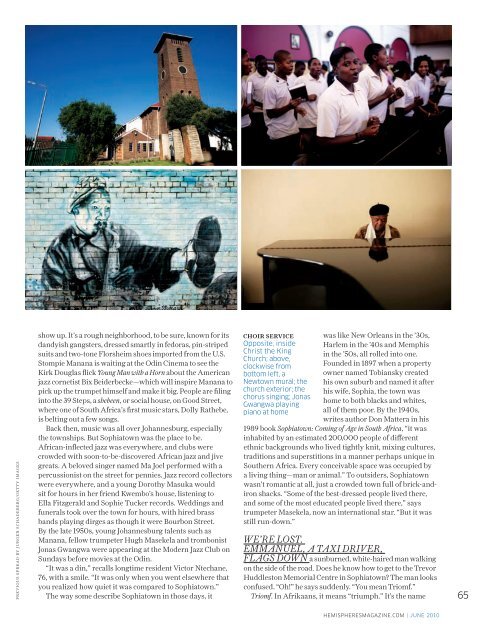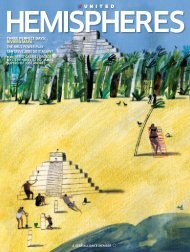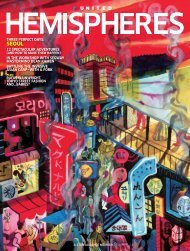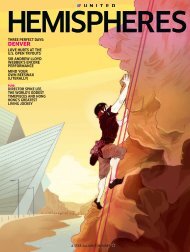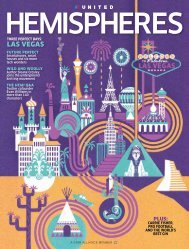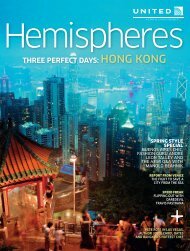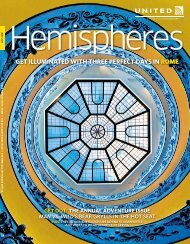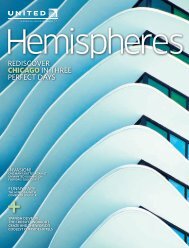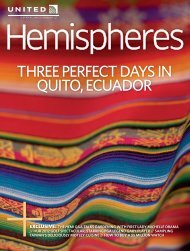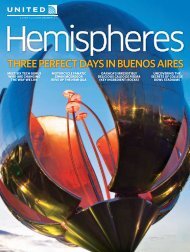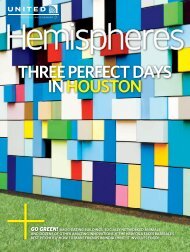june-2010
june-2010
june-2010
Create successful ePaper yourself
Turn your PDF publications into a flip-book with our unique Google optimized e-Paper software.
PREVIOUS SPREAD BY JURGEN SCHADEBERG/GETTY IMAGES<br />
show up. It’s a rough neighborhood, to be sure, known for its<br />
dandyish gangsters, dressed smartly in fedoras, pin-striped<br />
suits and two-tone Florsheim shoes imported from the U.S.<br />
Stompie Manana is waiting at the Odin Cinema to see the<br />
Kirk Douglas fl ick Young Man with a Horn about the American<br />
jazz cornetist Bix Beiderbecke—which will inspire Manana to<br />
pick up the trumpet himself and make it big. People are fi ling<br />
into the 39 Steps, a shebeen, or social house, on Good Street,<br />
where one of South Africa’s fi rst music stars, Dolly Rathebe,<br />
is belting out a few songs.<br />
Back then, music was all over Johannesburg, especially<br />
the townships. But Sophiatown was the place to be.<br />
African-infl ected jazz was everywhere, and clubs were<br />
crowded with soon-to-be-discovered African jazz and jive<br />
greats. A beloved singer named Ma Joel performed with a<br />
percussionist on the street for pennies. Jazz record collectors<br />
were everywhere, and a young Dorothy Masuka would<br />
sit for hours in her friend Kwembo’s house, listening to<br />
Ella Fitzgerald and Sophie Tucker records. Weddings and<br />
funerals took over the town for hours, with hired brass<br />
bands playing dirges as though it were Bourbon Street.<br />
By the late 1950s, young Johannesburg talents such as<br />
Manana, fellow trumpeter Hugh Masekela and trombonist<br />
Jonas Gwangwa were appearing at the Modern Jazz Club on<br />
Sundays before movies at the Odin.<br />
“It was a din,” recalls longtime resident Victor Ntechane,<br />
76, with a smile. “It was only when you went elsewhere that<br />
you realized how quiet it was compared to Sophiatown.”<br />
The way some describe Sophiatown in those days, it<br />
CHOIR SERVICE<br />
Opposite, inside<br />
Christ the King<br />
Church; above,<br />
clockwise from<br />
bottom left, a<br />
Newtown mural; the<br />
church exterior; the<br />
chorus singing; Jonas<br />
Gwangwa playing<br />
piano at home<br />
was like New Orleans in the ’30s,<br />
Harlem in the ’40s and Memphis<br />
in the ’50s, all rolled into one.<br />
Founded in 1897 when a property<br />
owner named Tobiansky created<br />
his own suburb and named it after<br />
his wife, Sophia, the town was<br />
home to both blacks and whites,<br />
all of them poor. By the 1940s,<br />
writes author Don Mattera in his<br />
1989 book Sophiatown: Coming of Age in South Africa, “it was<br />
inhabited by an estimated 200,000 people of diff erent<br />
ethnic backgrounds who lived tightly knit, mixing cultures,<br />
traditions and superstitions in a manner perhaps unique in<br />
Southern Africa. Every conceivable space was occupied by<br />
a living thing—man or animal.” To outsiders, Sophiatown<br />
wasn’t romantic at all, just a crowded town full of brick-andiron<br />
shacks. “Some of the best-dressed people lived there,<br />
and some of the most educated people lived there,” says<br />
trumpeter Masekela, now an international star. “But it was<br />
still run-down.”<br />
WE’RE LOST.<br />
EMMANUEL, A TAXI DRIVER,<br />
FLAGS DOWN a sunburned, white-haired man walking<br />
on the side of the road. Does he know how to get to the Trevor<br />
Huddleston Memorial Centre in Sophiatown? The man looks<br />
confused. “Oh!” he says suddenly. “You mean Triomf.”<br />
Triomf. In Afrikaans, it means “triumph.” It’s the name<br />
HEMISPHERESMAGAZINE.COM | JUNE <strong>2010</strong><br />
65


